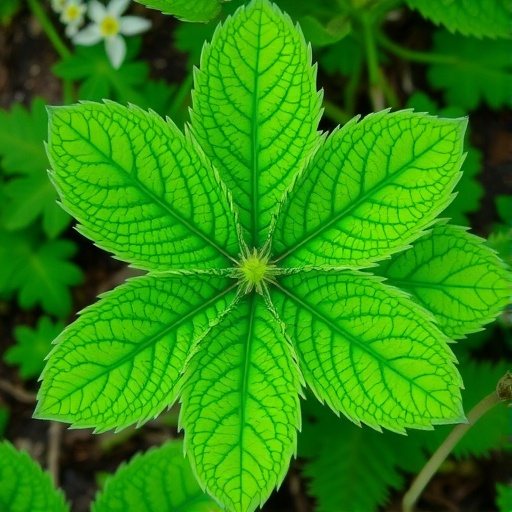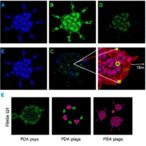In the verdant landscapes of China, a particular plant species, Isodon rubescens, has come under scrutiny by researchers seeking to understand its photosynthetic capabilities. This plant, which thrives in various ecological niches across the nation, offers a unique opportunity to delve into the intricacies of plant physiology. An insightful study led by expert botanist Jian Zaiyou has shed light on the diversity of photosynthesis in the leaves of Isodon rubescens, examining different leaf positions and their functional adaptations. This research not only emphasizes the plant’s relevance in ecological studies but also highlights the meticulous methodologies employed in studying this fascinating species.
The identification of Isodon rubescens was deeply rooted in the expertise of Zaiyou, whose credentials in botany lend considerable weight to the study. The research methodology adhered to strict ethical guidelines laid down by the Chinese government, ensuring that the collection and analysis of the plant material were both responsible and scientifically valid. The voucher specimens from this study are preserved within the Henan Institute of Science and Technology’s herbarium, making them accessible for future investigations and inspections. Such transparency in research practices fosters trust and collaboration in the scientific community.
Seeds of Isodon rubescens were collected in October 2021 from cultivated plants within an experimental site located in Xinxiang, situated in the Henan Province. The importance of collecting viable seeds cannot be understated, as they serve as the foundation for understanding plant growth, development, and ultimately, their ecological roles. The carefully sown seeds germinated in the spring of the following year, a clear indication of the plant’s adaptive traits and robust nature. By March 2023, researchers had successfully transplanted a selection of about 100 plants to a sunnier experimental location, enabling a more controlled environment for studying their photosynthetic characteristics.
The dynamic growth of the Isodon rubescens plants observed by May 2024 revealed their potential; with heights ranging from 40 to 80 cm and branching patterns encompassing 2 to 8 branches, these plants exemplified the vigor associated with a healthy, thriving species. The presence of multiple leaf pairs on each stem was noted, as variations in leaf structure often correlate with distinct physiological functions within the plant. The young leaves, angled strategically for optimal light capture, illuminated the significance of leaf positioning in enhancing photosynthesis—an aspect central to this study’s focus.
On May 16, 2024, a carefully selected sample of six Isodon rubescens plants became the focal point for examining the photosynthetic capabilities of leaves at designated positions on the stems. The researchers initiated their investigation by monitoring the photosynthetic rates of the uppermost leaves, known as the No. 1 leaves, which exhibited higher areas compared to other leaf positions. This selection was grounded in scientific reasoning, as leaf morphology plays a crucial role in the plant’s ability to engage in photosynthesis efficiently.
To quantify photosynthetic activity, researchers utilized a Li-6400 photosynthesis system, ensuring accurate measurements were obtained under consistent conditions. Light intensity, carbon dioxide concentration, temperature, and gas flow were standardized to eliminate external variation—a critical aspect when aiming for reproducibility in ecological studies. The researchers meticulously documented these parameters, reinforcing the reliability and precision of their photosynthetic assessments.
Parallel to measuring photosynthetic rates, the study examined the rapid light curves of chlorophyll fluorescence. This technique illuminated not just the photosynthetic efficiency but also the plant’s adaptive mechanisms in response to varying light conditions. Prior to measurement, leaves underwent a dark adaptation period, a method employed to gauge their dark-acclimatization potential. It is during this phase that the plant’s intrinsic properties can be observed, providing critical insights into the efficiency of photosynthetic photochemistry.
Further research activities included investigating light response curves for leaves at multiple positions along the stem. Conducted over two consecutive days, these measurements not only refined the data on photosynthetic rates but also expanded the understanding of how different leaves respond to light intensity across a gradient. The precision of their procedures, alongside the collection of extensive data points, laid the foundation for a nuanced interpretation of Isodon rubescens’ photosynthetic characteristics.
In analyzing the light response curves, the researchers opted for a modified rectangular hyperbola model, a recognized framework in photosynthesis research. This robust model was pivotal for illustrating the relationship between light intensity and photosynthetic rate, leading to greater clarity concerning plant performance under varied light conditions. The output parameters, including the net photosynthesis rate, light compensation point, and more, were crucial in developing a comprehensive profile of the plant’s photosynthetic dynamics.
To complement their findings, the investigators calculated critical benchmarks like the dark respiration rate and light saturation point. By understanding the thresholds beyond which photosynthesis becomes suboptimal or saturates, researchers can forecast plant behavior under environmental fluctuations—a pressing endeavor in the face of climate change. This aspect of research serves not only botanical interests but also agricultural perspectives, where understanding light dynamics can influence crop optimization strategies.
As sophisticated as the photosynthetic assessments were, the rapid light curves of chlorophyll fluorescence invoked a parallel depth of analysis. By applying models such as that proposed by Eilers and Peeters, the researchers effectively determined the electron transport rate in photosystem II, an essential component of photosynthesis. This measurement afforded them insights into the efficiency of photosynthetic electron transport under different light intensities.
One of the standout features of this research was the determination of the light intensity at which photosynthesis saturates and the subsequent calculation of maximum electron transport rates. The researchers meticulously calculated these variables, contributing to a clearer understanding of Isodon rubescens’ photosynthetic efficiency and potential applications in enhancing plant productivity, especially in varied environmental conditions. As the study progresses, the implications of this research could extend into practical realms of environmental management and agricultural innovation.
Data analysis played a fundamental role in interpreting the extensive datasets generated from the experiments. Utilizing the Statistical Product and Service Solutions (SPSS), the methodology ensured a rigorous statistical examination of results, leading to reliable conclusions that advance the scientific understanding of Isodon rubescens. The application of such comprehensive analytical techniques helped in validating observations and confirming correlations essential for deeper scientific exploration.
In conclusion, the intricate tapestry of photosynthesis in Isodon rubescens, as detailed in this study, highlights the complexity of plant responses to environmental stimuli. As researchers continue to peel back the layers of understanding regarding plant physiology, this research not only exemplifies the depth of inquiry achievable but also sets the stage for future explorations that could influence botanical sciences and beyond. Isodon rubescens serves as a critical case study in the broader narrative of plant adaptation, resilience, and the intricate relationships between flora and their environments.
Subject of Research: Photosynthesis diversity of Isodon rubescens
Article Title: Photosynthesis diversity of Isodon rubescens (Hemsley) H. Hara leaves at different leaf positions.
Article References:
Zaiyou, J., Susu, J., Xiaomin, T. et al. Photosynthesis diversity of Isodon rubescens (Hemsley) H. Hara leaves at different leaf positions. Sci Rep 15, 36996 (2025). https://doi.org/10.1038/s41598-024-76380-3
Image Credits: AI Generated
DOI:
Keywords: Photosynthesis, Isodon rubescens, Chlorophyll fluorescence, Light response curves, Leaf position, Photosynthetic rate, Botany, Plant physiology, Environmental adaptation.
Tags: ecological niches of Isodon rubescensecological significance of Isodon rubescensethical guidelines in plant researchherbarium specimen preservationIsodon rubescens photosynthesisJian Zaiyou botanical studyleaf position effects on photosynthesismethodologies in botanical studiesphotosynthetic diversity in plantsplant adaptation mechanismsplant physiology researchtransparency in scientific research


